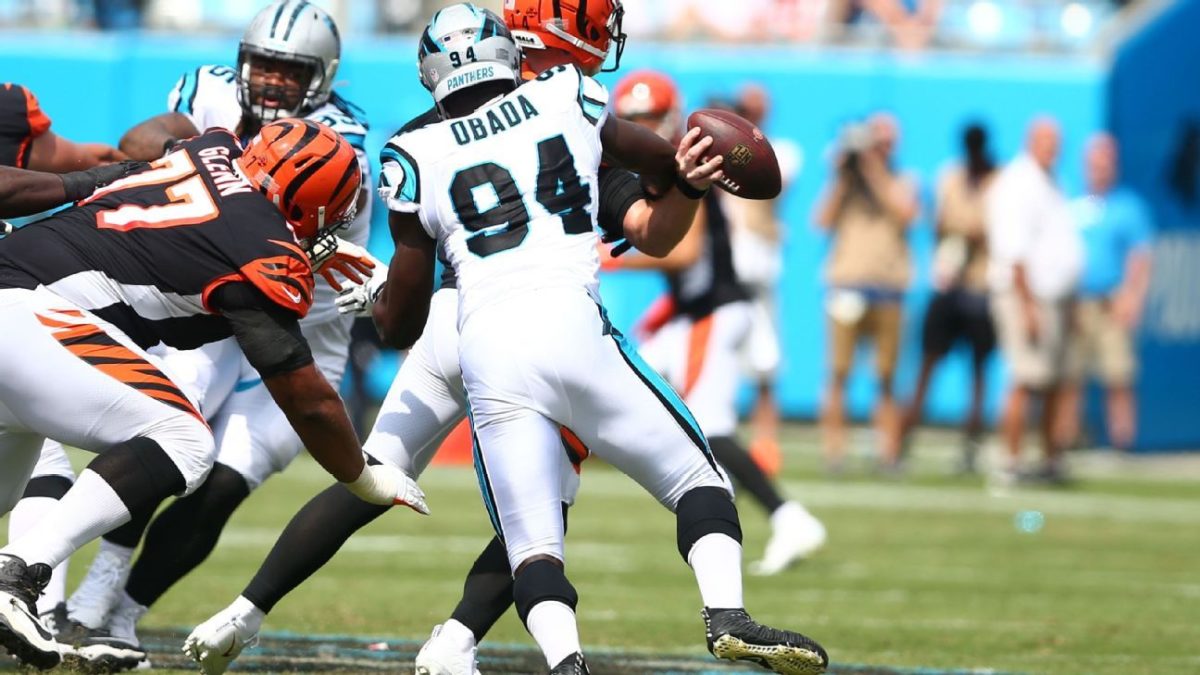Around The Edge
Obada might not be built like the classic speed rusher, but he has deceptive speed off the edge which allows him to create pressure. On his sack, the Bengals underestimated his speed and looked to block him with a tight end coming across the line. The tight end simply couldn’t get there in time and Obada was able to run right to the quarterback for the sack:
Similarly, on the final play of the game, it was likely only an uncalled hands-to-the-face penalty that prevented Obada from getting around the edge in time to get to Dalton:
Obada might not be Von Miller, but he has the speed to pressure all but the best tackles around the edge, and this in turn can be used to generate pressure in other ways. In fact, Obada’s near strip-sack demonstrated both what he is capable of becoming – as well as what he needs to do in order to become that:
Firstly, Obada does a good job of using his speed in the first couple of steps to force the tackle into a full slide, then fakes the inside move to freeze the tackle before committing outside and looking to turn the edge. When Cordy Glenn does commit outside, Obada shows another two positives in his ability to bend around the edge and the way in which he swats the tackle’s hands aside to get outside position. If he is able to combine his speed with the hand usage and bend shown here on a consistent basis, he will have a solid pass-rushing toolbox to use going forward.
However, there is one slight negative from this play, and this is something that Obada did a couple of times against the Bengals – the hesitation before committing outside. If used appropriately, a hesitation of this sort can be used to freeze the tackle for a second, thereby allowing Obada to get around the edge, but the issue for Obada is using moves like this appropriately. On the play above, for example, the tackle has already committed outside, possibly out of respect for his speed, as can be seen here:

Obada didn’t need to fake the inside move to freeze the tackle – out of respect for his speed the tackle had already put himself out of position and what Obada needs to do is take advantage of this. It is a testament to Obada’s skill and potential that despite this starting position, he is still able to get around the edge, but in order to maximize his impact as a pass rusher, Obada needs to do a better job of taking what the offensive tackle is giving him. While not as extreme an example, Obada makes a similar mistake on the following play:
On both of these plays, Obada still does a lot of good things, but if he can combine his speed around the edge with an awareness to take inside rushing lanes when presented with them, that should provide the basis for a highly threatening inside-out pass rushing game, as the following play clearly shows how much the Bengals’ left tackle was respecting his speed towards the end of the game:
Things To Improve On
As good as Obada was on Sunday, there are always going to be things for a player to improve on, especially a player in their first career game. Remember, an individual pass rusher gets home less than 10% of the time – even the really good ones – and Obada’s mistakes on the following plays are not critical flaws to his play; rather, they are slight imperfections in what was a genuinely excellent first career game. There is, however, something of a pattern to these imperfections, which in some ways makes them easier to fix if Obada is able to focus on them as problem areas.
All four of the following plays relate to hand usage, and on two of the plays, the issue is simply that Obada fails to get his hands up fast enough, in the first case allowing the tackle to get his hands inside his frame without contest, and on the second leading him to get too close to the tackle before making contact, allowing the tackle to once again grab him around the shoulders, thereby preventing Obada from shedding the block effectively:
This is an issue that should be relatively easy to fix, as there is no issue here in terms of Obada’s coordination or athleticism, but rather a lack of learned habit about getting his hands up with enough time before contact to be sure of the first strike. On the next two plays, he times his strike well but slightly misjudges the location:
Here, Obada is looking to strike with his inside arm at the outside shoulder of the tackle, with the aim of them using his outside arm to knock down the outside arm of the tackle, allowing Obada to pivot round the tackle and turn the edge back towards the quarterback. This is something that players like Von Miller have made the staple of their outside rush and is a hugely effective move when executed well:
The issue with what Obada does, however, is that when he makes his initial strike, his hand placement is too far towards the inside shoulder of the tackle, forcing him to square his frame to the tackle and thereby expose it – which the tackle happily grabs, thereby making it hard for Obada to turn the corner. If he can avoid pivoting inside with his punch he will likely have more success with this move going forwards.
Obada’s story was a good one when he made the 53 man roster, it was better when he got a game jersey and reached even greater heights when was named NFC Defensive Player of the Week, but based on what he showed on tape against the Bengals, this is a story that may only just be beginning.



